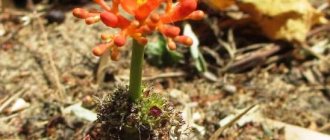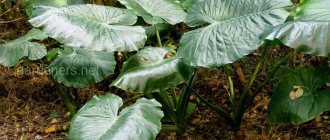Since time immemorial, laurel has been famous for its decorative, healing and culinary properties. In Ancient Greece and Rome, a wreath made from this plant was considered an indispensable attribute of the god Apollo and the Roman emperors. It was a symbol of success and triumph, which was awarded to the winners of military battles and sports competitions. Laurel has become a real decoration of southern gardens and estates, and bay leaves are used in the preparation of many dishes. Although the plant belongs to the genus of subtropical shrubs and trees, the crop is quite unpretentious and can withstand light frosts, which allows it to be grown in summer cottages, as well as indoors.
bay tree
Description of culture
Laurel belongs to the evergreen subtropical plants of the Laurel family. The main habitat of the culture is the coasts of the Mediterranean and Black Seas, Transcaucasia, the Canary Islands, and the Azores. The genus of culture consists of two types - noble and Azorean (Canary) laurel.
There are many popular names for noble laurel - real, Greek, sweet, laurel tree. Decorative cultivation of this plant began in the middle of the 16th century. It is an evergreen tall shrub or tree that can reach 6 m in height. Elongated oval leaves from 4 to 8 cm wide and up to 20 cm long have a matte surface. The fruits are black with a blue or brown tint and reach up to 2 cm in length. When grown indoors, it rarely blooms.
A bay tree can grow up to 6 meters in natural conditions, but it is often grown indoors.
The main habitat of the Azores laurel is the Canary and Azores Islands, where the name of the species comes from. Trees can grow up to 15 m high. Leaves are 6-8 cm wide and up to 15 cm long.
Regardless of the type of crop, the bay leaf has a dark green color and a dense leathery structure. They grow in the shape of an elongated ellipse with wavy edges and a narrow edging of a light shade. The foliage is characterized by a high content of essential oils, the largest amount of which occurs in the 5-6th year of development of the laurel bush or tree.
Important! In spring, about a third of the old leaves of an adult plant may fall off.
The plant blooms once a year - in the second half of spring. The flowers are inconspicuous in appearance, yellow in color, collected in an umbrella-shaped inflorescence. The fruits are small, single-seeded berries of blue-black color.
The plant blooms once a year and has small, dim yellow flowers.
To grow, the plant requires warm weather up to +26°C, bright but diffused sunlight. Laurel tolerates shade well. Exposure to direct rays negatively affects the development of foliage. The crop is unpretentious to growing conditions and can tolerate short-term frosts down to -15°C. The plant is resistant to high humidity and requires abundant watering in summer and minimal watering in winter. At home it can live up to 15 years. For normal development, young seedlings will need to be replanted in the first two years, adult plants - every 4 years. If necessary, formative pruning of branches is carried out in March.
Best position for the plant
Laurus nobilis is an evergreen ornamental shrub, grown in our conditions only in pots. Noble laurel grows well in conditions close to its natural environment. The plant needs a sunny, warm position - it is better to grow on a sunny windowsill. The bush should be well protected from the wind - it should not be placed near windows or doors where there are strong drafts. Laurel bushes look good on window sills. In summer, the pot can be placed on the balcony or in the garden.
Camphor laurel (tree)
One of the popular varieties of laurel plants that are grown at home or in garden plots is camphor laurel (another name is camphor tree). Strictly speaking, in the scientific classification this plant belongs to the species of the genus Cinnamon. However, its belonging to the Laurel family gives grounds for amateur gardeners to classify the crop as a variety of laurel.
Another representative of the Laurel family is camphor laurel.
The regions of Southeast Asia - Taiwan, southwestern China, some islands of Japan, Korea, and Indonesia - are considered to be the birthplace of camphor laurel. Subsequently, this subtropical evergreen plant spread to many countries with warm, humid climates. In the second half of the 18th century, the camphor tree appeared on the Caucasian coast of the Black Sea. Initially it was grown as an ornamental plant in gardens, parks and estates. In the 19th century, the use of culture for industrial purposes began.
The main beneficial quality of the plant is its essential oil content, more than 90% of which is camphor. This substance has medicinal properties and is used in the manufacture of various medications. Camphor ointments and tinctures are used to cure rheumatism, arthritis, diseases of the heart, blood vessels, and disorders of the central nervous system. The largest amount of camphor is found in the woody parts of the laurel - the trunk and branches. However, essential camphor oils are also contained in the leaves, flowers, and fruits of the plant.
Important! The leaves of the plant are also used as spicy seasonings in the preparation of various dishes.
Camphor laurel is valued for the presence of a large amount of camphor, which is used in medicine and cooking.
The camphor tree is distinguished by its growth rate; it can reach a height of 20-50 m with a massive trunk up to 5 m in diameter. Such plants love warmth and moisture and develop well in subtropical regions. In addition to camphor extraction, they are used to create park and garden decorative compositions and hedges. However, powerful root systems can cause the destruction of various sewer, drainage, and communication systems. In addition, the foliage of the tree contains substances that deteriorate the quality of fresh water in soils and reservoirs.
There are decorative forms of camphor tree that can be grown indoors or in a summer cottage. The technique for growing such a crop is generally similar to the cultivation of noble or Azorean laurel, but requires more fresh air. For propagation, the methods of planting seeds and semi-lignified cuttings or layering are equally successful. The optimal soil composition for camphor laurel is a mixture of two parts turf and one part each of earth, sand, peat, and humus. The plant usually blooms in late May, early summer, and bears fruit in November.
Camphor laurel is often grown for decorative purposes - to create compositions and hedges.
Noble laurel: varieties
The most common type. It is very unpretentious and can easily withstand drought in its natural environment. Can be cultivated as a houseplant. It is not afraid of rooms with central heating and low air humidity.
The varieties are not particularly diverse. Several varieties of Laurel have been developed:
Narrow-leaved (Willow-leaved)
It is characterized by narrow, long leaves, reminiscent of willow foliage, of a light green color.
Caesar
A variety of one of the varieties with narrow leaves.
Wrinkly
A feature of this variety is the strong waviness of the edges of the leaf plate.
General requirements for growing laurel
To grow a laurel tree or bush in an apartment or country house, you can use both shaded and sunny places. In summer, an open balcony or garden plot is suitable. For wintering you can use a glassed-in loggia, a greenhouse, or a well-lit room. In this case, the main condition for the normal development of seedlings is maintaining optimal ambient temperature. During the active growing season - from +18 to +22°, in winter - in the range of 10-12° above zero.
Laurel does not have clearly defined periods of winter dormancy. The intensity of growth is determined by the surrounding temperature conditions and the degree of lighting. However, the plant needs a certain period of rest.
Important! In winter, the laurel can be kept on an insulated balcony; during extreme cold, it can be brought into a well-ventilated room.
A bay tree can cope with slight frosts, but it is better not to leave the plant in the cold.
Usually the plant can withstand short-term frosts down to -10°, cold-resistant varieties - up to -15°, but it is better not to keep seedlings in frozen soil. The crop can be grown in open ground only in areas with a warm climate, with above-zero temperatures throughout the year. In temperate climatic latitudes, a bay tree or bush can be planted in tubs and kept indoors or in a greenhouse in winter. During the period of intensive growth, laurel is most vulnerable to frost, so in the spring you should not rush to take it out into the fresh air.
Where does it grow
The bay tree prefers a warm subtropical climate with winter temperatures of at least 8–10 °C. Laurel nobilis grows in:
- Italy,
- Greece,
- Spain,
- Turkey,
- Transcarpathia,
- Transcaucasia,
- Crimea,
- Krasnodar region.
The Azores species is common in the Canary and Azores Islands, Madeira. Camphor laurel is dominant in Asia:
- southern part of China,
- Japan,
- Taiwan,
- India,
- Korea,
- Vietnam.
Distributed and cultivated in East and North Africa, the southern states of America, Mexico and Brazil, and the fertile territories of Australia.
Carrying out laurel transplants
The root system of laurel bushes and trees is quite vulnerable to damage. At the same time, the roots gradually grow, and the plant must be replanted periodically. This should be done using the transfer method - carefully remove the laurel from the flowerpot along with clods of earth, then move it to a larger container.
When the roots grow too much, the plant must be carefully transplanted into a larger pot. They do this by transfer method
We can highlight the following requirements for transplanting laurel seedlings at home.
- With normal development, young shoots are replanted once every 2 years. When growth is slow, replanting is done less frequently so that the root system is properly strengthened.
- Plants over 4 years old are replanted every 4 years.
- Before transplanting, water the soil in the flowerpot generously and wait until the water is completely absorbed. This will make it easier to separate the lumps from the walls of the container. Then the plant is carefully removed and laid sideways on oilcloth or fabric.
- The plant is inspected, pebbles stuck in the root plexuses are carefully removed, and damaged roots are cut off. For quick healing, the cut sites are treated with charcoal powder.
If damaged roots are found, you need to cut them off and treat the “wound” with charcoal - The pot into which the crop is moved should be approximately 2-3 cm larger in diameter than the previous container.
- It is necessary to make holes in the bottom of the flowerpot and lay a drainage layer to drain excess water, which will protect the roots from rotting. You can use small pebbles for this.
After all the procedures performed, the plant is planted in a new container. Laurel is unpretentious to soil characteristics, but for better growth you can add humus. A little sand is added to the clay-saturated soil to improve breathability and moisture absorption. On the contrary, you can add a little clay to sandy soil so that water is retained in it longer.
A drainage layer must be placed at the bottom of the pot to prevent root rotting.
The optimal ratio of soil components for growing at home is two parts of turf and one part of sand mixed with humus. In the first year, it is not necessary to fertilize the soil, then you can apply any complex fertilizer 3-4 times during the season. In the year when the plant is not replanted, it is necessary to add soil to the flowerpot and update the soil.
Important! The soil around the laurel bush or tree trunk must be loosened periodically.
Landing
In the middle zone, it is recommended to grow laurel only indoors. One of the compromise options is to plant in pots or tubs, which can be exposed in the fresh air in the summer and brought indoors in the fall.
You can get a beautiful indoor plant from seeds. It is recommended to sow them in February or March. The seed material is first freed from the fruit shell and soaked for 2–3 hours in a warm pink solution of potassium permanganate. The seeds are sprouted in a mixture of sand, soil and peat. They deepen the soil 1 cm, water it and cover the surface with film. Keep containers in a bright room at an air temperature of 20–24 °C. After the sprouts appear, the protection is removed.
Pruning and crown formation
Typically, pruning of branches and formation of the crown of the plant is carried out in March, if by this time the young shoots have managed to grow. Some gardeners recommend performing this operation in August so that new branches will grow the following spring.
To improve the development of the laurel, old woody branches are cut off by about 20 cm. Below the cut, a sufficient number of buds should remain so that the shoots that grow from them subsequently form a voluminous crown.
Once a year, in March or August, it is worth pruning the plant - this will ensure active growth of the crown
With the help of pruning, laurel crowns can be given a wide variety of decorative shapes - a ball, a cone, a pyramid. This procedure must be started from an early age of seedlings.
Important! To give the desired shape, you need to trim the branches a little, but often.
Diseases and pests of home laurel
Most often, leathery leaves are damaged by scale insects and scale insects. They are easy to identify with regular inspection. First, the parasites colonize the underside of the leaves. For minor infestations, they are removed manually using a soapy sponge and shower. If the case is advanced, you will have to use special preparations, but then the leaves cannot be eaten.
Dry air in apartments causes the appearance of spider mites, to destroy which traditional methods or acaricides are used.
Excessive watering causes water to stagnate, which causes root rot and fungal diseases to appear. Externally, they appear as brown spots.
Too warm, dry wintering can cause leaf fall.
Laurel is actually quite easy to maintain. If properly cared for, it will become not only an interior decoration, but also a wonderful homemade seasoning.
Frequency and abundance of watering
In the wild, laurel grows in coastal zones and, accordingly, tolerates high humidity well. The surface of the leaves should be periodically wiped with a damp sponge or cloth. At home, once a month, the plant needs to be hosed down with a stream of warm water under pressure, while covering the soil with polyethylene.
To maintain the required level of humidity, the pot with laurel must have a drainage layer and holes. The container with the plant should be placed in a tray with pebbles and moss at the bottom, which should be regularly moistened.
Laurel loves high humidity, so it is recommended to wipe its leaves with a damp cloth, and also periodically give it a shower
Water the laurel once a day with a moderate volume of settled water at room temperature, in the morning or evening. During dry periods and during hot weather, watering can be done more often. In winter, for the normal development of the crop, it is necessary to maintain the plant's dormancy; increased humidity during this period can disrupt its life cycle, so the frequency and abundance of watering in the winter months should be reduced.
Important! It will be useful for plants to add baking soda to water at the rate of 7 teaspoons per liter.
Main characteristics
Laurel is a houseplant that even novice gardeners can care for. Under natural growing conditions, this tree can reach a height of 18 meters. By the way, in the Sochi area you can find specimens that are 15 meters high.
Despite the fact that laurel does not require special care, it is still desirable to create the most favorable environment for the plant. Indoor culture prefers to be in a sunny place, however, it will grow well in the shade. Also, a plant such as laurel is not afraid of drafts and drought. Care at home should be carried out so that it does not experience stress due to lack of water, or, conversely, does not suffer from waterlogging of the soil.
Seed propagation of laurel
When using the seed method of propagating laurel at home, gardeners often encounter certain difficulties. The fact is that the seeds of the crop quickly lose a large percentage of their germination capacity, within 3-5 months. In addition, the high oil content significantly slows down their germination, which can last up to six months. For these reasons, it is necessary to use the freshest possible seeds, and you will have to wait quite a long time for the results of sowing.
Seeds are usually planted in the first months of winter. In order to speed up germination, seeds can be pre-treated with a special solution that stimulates growth. The depth of the planting should be about 1.5 cm. Before this, the soil must be loosened and moistened. Then the soil is covered with plastic film. Containers with planted seeds are kept in regularly ventilated rooms at a temperature of about +18°, the soil is constantly moistened.
You can propagate a bay tree by seed, but you will most likely have to wait a long time for germination - about six months
Important! Every week, the seeds should be carefully removed and inspected to prevent mold from developing. If a white coating is detected, it must be carefully removed and the seed washed with a weak solution of potassium permanganate.
When the shell cracks and the seeds begin to germinate, they must be transplanted into separate flowerpots. The sprouted seed is planted at a soil depth of about 5 cm, the first shoots usually appear a month later. Young sprouts should be protected from direct sunlight and heat.
When propagating by seed in open ground, ripe fruits are collected from laurel bushes and trees and the seeds are extracted from them. This usually happens in late autumn. The collected seed material is planted in the prepared area at a distance of about 8 cm from each other. The planting depth is approximately 5 cm. The first shoots sometimes appear as early as January, but usually these are weak shoots that die quickly. Typically, shoots appear at a constant temperature of about +22° from May to the end of summer.
Some gardeners prefer to grow laurel from seeds directly in open ground, but this is recommended only in regions with warm winters
Classification
In total, there are about 40 varieties of laurel trees, differing in the shape of leaves, inflorescences and having their own developmental characteristics. All of them belong to three main types.
Noble laurel
Homeland - Mediterranean coast. More often it forms shrubs or low trees. The height of the trunks is 4–7 m, the crowns are narrow pyramidal. The leaves are bright green, glossy, 6–10 cm long, with a characteristic spicy aroma. Laurel blooms in April. The tassels are light yellow. At the beginning of autumn, bright black smooth drupes ripen on the branches. Noble laurel lives up to 60–70 years.
Azores laurel
Large plant: tree up to 15 m high with a dense, wide crown. Heat-loving and moisture-loving species. Decorative. The shoots are slightly pubescent, the leaves are wide, leathery, bluish-green, 10–12 cm long. The clusters of inflorescences are yellow, the calyxes are 8–10 mm in diameter, bloom in April or early May.
camphor laurel
Far Eastern moisture-loving species. A tree up to 10–12 m high, with trunks up to 30–45 cm thick and spreading dense crowns. The leaves are shiny, dark green, large. The length of the leaf blades is 10–17 cm. Inflorescences: sparse paniculate racemes of 3–12 small greenish calyxes. All parts of the tree contain an essential oil rich in camphor. Greens and flowers emit a characteristic pungent aroma.
Application of vegetative propagation by cuttings and layering
At home, laurel is propagated by cuttings in the first months of spring or in June-July. Cuttings in open areas are carried out only in the first half of summer.
The cutting is cut from a semi-lignified shoot located in the lower or middle part of the laurel bush or tree. The future seedling should have three internodes about 8 cm long. In this case, the bottom leaf must be removed and the rest shortened by half.
The cuttings are planted in moistened sand at an ambient temperature of 16-20°, deepening the seedling by about 1.5 cm. Then the planting is sprayed and covered with plastic film. The cuttings take root and begin to grow within a month. As soon as they grow 2-3 cm, they need to be transplanted into separate containers.
Cuttings usually take root within a month.
Important! Another method of vegetative propagation involves planting layering - lateral shoots with a root system beginning to develop. Such shoots are carefully separated from the laurel, the cut sites are treated with powdered charcoal, then planted in the same way as the cuttings.
Soil requirements
Laurel may lose leaves if there is no suitable substrate.
The plant loves the soil:
- fertile;
- permeable;
- pH is neutral to alkaline (pH 6.5-7.5).
You can, of course, pour universal soil or ordinary garden soil mixed with it into the pot.
The bay tree will grow well in a container that is not too large.
The bay bush does not like too much space in the pot - then it “goes” more into the roots, and in a small container the above-ground part develops and grows faster.
Calendar of basic work on growing laurel
When growing and caring for laurel in open ground, you can follow this schedule for basic work.
| Season | Recommendations |
| Spring | In March and April, sanitary pruning of bushes and trees is carried out, removing damaged, woody and frozen shoots. Rooting of cuttings is carried out in cool greenhouses. Fertilize plants. |
| Summer | During the entire period, germination of seeds sown in autumn takes place. With this propagation option, it is necessary to regularly feed the soil with nutritional supplements. In June and July, cuttings are planted. August is the time for crown-forming pruning of bushes and trees. |
| Autumn | In October and November, ripened fruits are collected and seeds are sown. At this time, leaves are collected from adult plants for the purpose of preparing culinary or medicinal raw materials, and damaged, diseased shoots are pruned. |
| Winter | During this period, it is necessary to maintain a dormant regime, moderate the frequency and abundance of watering, and keep the plants in cool, bright, well-ventilated areas. |
In autumn and winter, the plant is disturbed minimally, since it is in a dormant state.
Such seasonal work is carried out at home.
| Season | Recommendations |
| Spring | The seeds are sown in March. In the first two months, propagation is carried out by vegetative methods by planting cuttings or layering. Regularly feed the soil. |
| Summer | During the entire period, seeds germinate and regular fertilizing is carried out. At the end of summer, formative pruning is performed. |
| Autumn | October and November are the time to collect fruits and raw materials from leaves. Feeding is rare. |
| Winter | The first two months are a rest period. In February, seeds can also be sown. |
In spring and summer, the plant needs to be periodically fed, watered, and pruned.
The plantings are regularly watered throughout the year. In summer, plants are watered more often and more abundantly. In winter, the intensity and volume of watering should be reduced.
Lighting
In order to preserve the decorativeness and beauty of the laurel foliage, it is advisable to place it on a light, warm, well-lit side. Despite the fact that the flower feels normal in the shade, its color may change slightly, the leaves will no longer have such a bright color, and the tree itself may stretch out and the foliage may thin out.
In indoor conditions it is very difficult to achieve flowering of a plant such as laurel. Care at home, consistent with natural factors, can help the tree bloom. True, his flowers are not very beautiful. Basically, these are small inflorescences of yellow flowers that have a pleasant aroma.
Bay leaf home care lighting
Laurel is not at all afraid of direct sunlight and thrives on brightly lit southern windowsills. In summer, of course, he will like it more outdoors - in the garden or at least on the balcony or veranda. However, you should not abuse the sun’s rays immediately after purchasing a seedling, or after a cool winter. If you are not used to it, laurel can get sunburned. Therefore, bright sunlight must be added gradually.
Possible problems when growing and caring for laurel
Beginning gardeners need to prepare in advance to overcome a number of problems that may arise in the process of growing laurel at home or in a summer cottage. For example, the following reasons can lead to drying out of laurel trees and bushes:
- low humidity in planting areas during the period of active growth of laurel;
- improper irrigation during the winter or growing season;
- excess moisture in the root system, which leads to rotting of the roots, spots on the leaves, and yellowing of the foliage;
- non-compliance with temperature conditions, sudden temperature changes.
If watering is improper, or insufficient or excessive humidity, the plant may begin to hurt.
Important! In addition to errors in caring for the plant, some insect pests, dangerous airborne diseases and various parasites pose a threat to the health of the laurel.
Shields
Insects are white, sometimes with a yellowish tint. They are distinguished by the presence of a shield-like shell, from which they got their name. They settle on the surface of foliage and feed on plant juices. As a result of the influence of pests, white or yellow spots form on the leaves, which gradually cover the entire leaf. Then the foliage dries out, curls and dies. Insects multiply quickly and spread to all nearby plants, so it is important to immediately isolate the infected bush or tree from neighboring vegetation.
The dense shell protects the scale insect from exposure to insecticides, which makes it difficult to combat the pest. The surest way to get rid of insects is to collect them from the surface of the leaves by hand. The areas affected by the pest should be treated with Ankara or a tincture of vodka and garlic. A solution of a liter of water, 15 ml of liquid soap and 10 ml of alcohol is also suitable for pest control. This composition should be used to wipe the surface of the leaves.
Important! When scale insects appear, it is also necessary to change the top layer of soil near the plant, where insect larvae may be located.
Scale insects are dangerous for the plant: they feed on its sap, causing spots to appear on the leaves
Spider mites
Small insects that are difficult to notice with the naked eye. A sign of pest influence is the appearance of cobwebs and white plaque on the soil, surface of leaves, and plant branches.
To protect the laurel from mites, treat the crop with a weak solution of potassium permanganate diluted with water. Infected plants are treated with insecticidal preparations. The surface of the leaves and branches is also wiped with a soap solution, followed by rinsing the plant with clean water.
A sign of the appearance of such a pest is the appearance of small cobwebs and plaque on the plant and soil. You can get rid of it using potassium permanganate
Sooty fungus
Fungal spores are carried both by insects and through the air. A symptom of the disease is the appearance of dark spots resembling soot on the surface of the leaves. The fungus leads not only to damage to the appearance of the plant, but also to its death. To combat the disease, various fungicides are used, the most effective of which is Bordeaux mixture.
Sooty fungus
Why does bay leaf dry out at home, what should I do?
If the bay bush begins to dry out and yellow leaves begin to appear, which also lose their shine, the plant may have a number of reasons for this condition:
- Waterlogged soil, which results in root rot.
- “Tired” soil that does not provide the plant with important amounts of nutrients.
- There are pests in the root system or on the plant
- The temperature regime is not maintained: too cold, too many drafts.
- The plant suffers from direct sunlight
- The plant needs replanting or a larger pot.
Healing properties of the plant
Laurel trees and shrubs have a number of healing properties. The foliage releases substances that reduce the content of staphylococcus bacteria and fungal spores in the air. This quality helps normalize the cardiovascular and respiratory systems, blood circulation in the brain, and relieve mental fatigue. In pharmacology and folk medicine, in the production of raw materials for medicines, in addition to leaves, the bark, fruits, and seeds of the plant are used. Various preparations based on laurel are used to relieve nervous excitability and fatigue, cure paralysis of the facial nerve, colic, inflammation of the liver, spleen, and joint pain.
Bay leaf infusions help get rid of pathologies of the bladder, uterus, and hearing organs. Decoctions of seeds and bark cure cholecystitis and urolithiasis. Oil extracted from the leaves reduces pain during childbirth and cramps.
Using bay leaves in cooking can increase appetite, improve digestion, and lower blood pressure. Thanks to the presence of tannins, tinctures and ointments based on laurel relieve swelling, inflammation, and reduce pain from rheumatism, arthritis, bruises, and sprains.
Various medicines made using laurel help against many diseases.
The substances contained in the plant serve as good natural antibiotics and have antifungal and disinfectant properties. They can slow down the development of tuberculosis, activate metabolic processes, help fight many diseases and strengthen the immune system.
Important! Bay decoction is an effective remedy that allows the body to quickly recover from serious illnesses.
Tinctures from leaves, flowers, and fruits of laurel are used as diaphoretics, help in curing fever, stomatitis, and remove gallstones, salts, and toxic substances from the body. The insecticidal properties of the plant components are used in the production of medicinal ointments and antibacterial soap. Bay decoction is useful for patients with diabetes. Taking this remedy for three weeks will significantly reduce blood sugar and normalize the general condition of the body.
Bay laurel is used to create antibacterial soap
Application
Laurel trees are used for landscaping gardens and home areas in regions with a suitable climate. They can be grown as indoor and greenhouse crops.
The leaves, due to the content of essential oil, which has a subtle bitter aroma, are used to flavor canned meat and vegetable products. Whole or ground into powder, they are included in spicy mixtures, brines, sauces, and marinades. The preparation of roast, pilaf, goulash, jellied meat, fish and meat casseroles, and soups is incomplete without bay leaf.
Bitterness, resins and oils of laurel are used in pharmacology and folk medicine. Camphor, isolated from the leaves and wood of the same species, is included in liniments, ointments and solutions for anesthesia for injuries, rheumatic and dermatological diseases, irritations and inflammations. Essential and fatty oils have an antiseptic, astringent, sedative, regenerating, and hypoglycemic effect.
An infusion of bay leaves is used to alleviate well-being in case of neuroses, migraines, neuralgia, arthralgia, muscle pain, diabetes, and arrhythmias. Extracts and ointments based on laurel oil are used to anesthetize poisonous insect bites and eliminate boils.
Use of laurel in cooking
Thanks to its special aroma and taste, bay leaf has become one of the most sought-after spices in the world. It is an essential ingredient in most soups, broths, porridges, gravies, sauces, pickles and marinades. The spice is used in preparing dishes from vegetables, cereals, fish, meat, and also as a component of various seasonings.
Dried laurel leaves are mainly used in cooking. However, there are many recipes that use fresh leaves and seeds of the crop. The essential oils contained in laurel are also used in confectionery production and the production of alcoholic beverages.
Important! Most canned vegetables such as tomatoes, cucumbers, zucchini, eggplants, squash, peppers, and various cabbage, carrot, and onion salads cannot do without bay leaves.
To impart a unique aroma and unique taste, dried laurel leaves must be added at the final stage of cooking, otherwise the seasoning will make the dish too bitter and spoil its taste. You can put the leaves in freshly prepared food, leave them for a while, then remove the spice. This method will also give the dish an appetizing smell and improve its taste.
Bay leaf is a fairly popular spice that is used in preparing various dishes.
Planting the top of a pineapple at home
This plant is propagated by seeds and cuttings. The first method is rarely used by amateur gardeners: laurel seeds cannot be stored for a long time, since their germination capacity is quickly lost. Therefore, when buying seeds, the chance of purchasing a low-quality product is very high.
Laurel cuttings are carried out in March, since only in spring the cut cuttings can take root. In summer and autumn, the cuttings do not take root and disappear.
Semi-lignified branches about 10 cm long, which have at least 3 internodes, are suitable for rooting. They are treated with a root growth stimulator and rooted in soil covered with a thick layer of sand.
For successful rooting, it is necessary to cover the cuttings with a glass jar and maintain the temperature at 22-25ºC. Typically, cuttings take root within a month.
Selection and storage of bay leaves
One of the advantages of laurel is that it is equally useful both fresh and dried. For medicinal or culinary purposes, you can use leaves freshly picked from a home-grown bush or tree, or dry them into preparations that will then be stored for a long time.
Important! At the same time, dried leaves also contain essential oils and have disinfectant, antibacterial and medicinal properties.
When choosing bay leaves, you need to carefully examine their surface. There should be no stains or any plaque on them. The maximum amount of oils and nutrients is contained in the foliage of adult plants that have reached the age of 4-5 years, therefore it is from such leaves that it is better to dry preparations for seasonings or medicinal tinctures, ointments, and decoctions. To do this, carefully cut branches with leaves from the laurel and dry them in a dark place for 10 days. Then the leaves are separated and transferred to a separate container.
You can use both fresh and dried bay leaves
Dried leaf material should be stored in airtight containers. To do this, you can use glass jars with tight-fitting lids. It is better to keep transparent containers in a dark place. Typically, the shelf life of dry bay leaves is one year, but as long as the packaging is kept sealed, the bay can be stored longer. However, it must be taken into account that over time the taste of such a seasoning deteriorates and the leaf begins to taste bitter in dishes.
How to buy a good seedling
Before purchasing a seedling, you should check whether it is in good shape. The main thing is to assess whether the leaves are intact. Leaf blades should be well and evenly colored. They should not have pests or traces of their presence (damage, holes in the leaves).
Laurels are quite susceptible to pests, especially mealybugs. These scale insects also threaten other houseplants, and an infested shrub can cause other plants to become infected. Laurel should be transported from the store carefully, especially in winter, as a sharp drop in temperature can be a shock to it.











